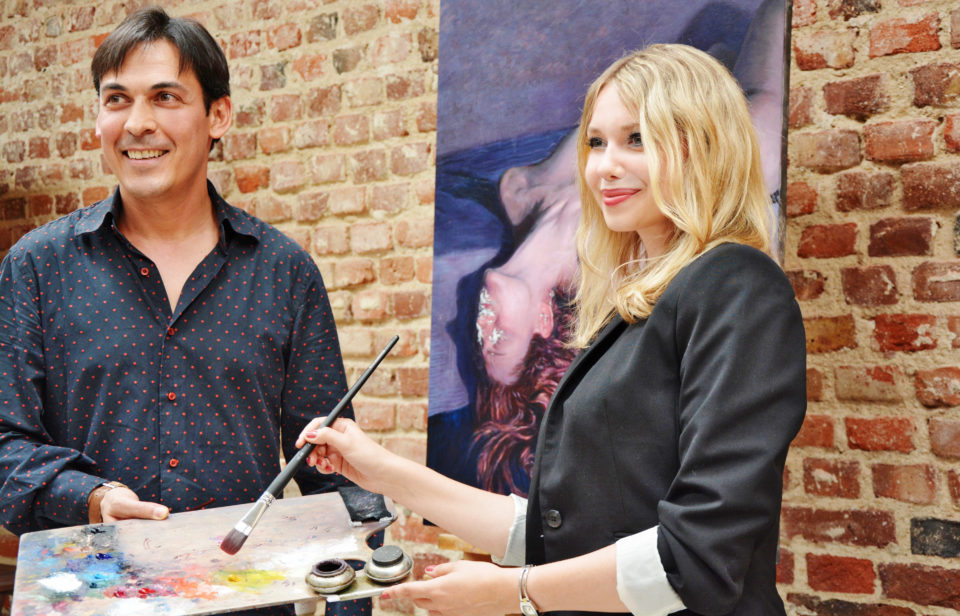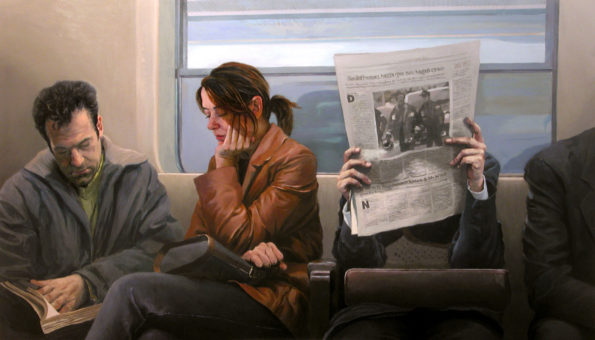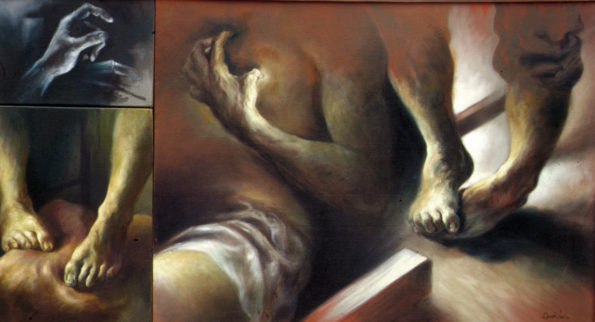REALISM AS AN ENDLESS PROCESS OF COGNITION
![]()
![]()
Realism in art has a long tradition. The French painter Gustave Courbet founded Realism in the nineteenth century. It emerged as a reaction against Romanticism. Courbet defined realistic art exclusively as one that represents motifs that can be seen and touched by the artist. Today Spain is considered a precursor of the realist movement, where this style has evolved considerably over the last forty years. Cristian Avilés is one of these precursors. Avilés toured Europe with his paintings, was especially noticed in Germany, which is considered one of the countries that has led all the artistic vanguards in the field of Expressionism, Abstraction, Conceptual Art and Performance Art.
Cristian Avilès began his career in Chile, one of his masters was Claudio Cortéz. In 1999 he came to Europe and visited Berlin, Paris, London and Rome. After that he took up residence in Madrid. He was awarded the Arauco Foundation in Chinchón where he met another important teacher for his career – Guillermo Muñoz Vera. Until 2009 he participated in numerous exhibitions in Europe. Met by JL Interview Magazine in his Spanish studio, Academia de pintura Cristian Avilés, in Calle de José Ortega y Gasset, 92, Madrid, artist explained: “I love Spain. Since 1999 I had been living in Chinchón, then I moved to Madrid. It is my second home and I find people open-minded here. Chile is and will always be present in my work. They leave a footprint that I come from there”.
The painter presently works and teaches at his Academy. “I teach painting as a supplement for fixed income. It is my need and I love to do it”, he admitted. Again and again Avilés is invited by various international galleries to exhibit his extraordinary expressive realistic paintings. In the past, in 2004 he participated in the Fair of Contemporary Art “ArtLondon Fair 04” and in 2006, in “Art Salzburg 2006”. Realism for him is currently an artistic movement: fully valid and important. He broke with propaganda and ideological purposes and focused his attention on emotions. His realism is a copy of social reality, like this last work “People in Subway”.

Today your painting is figurative and experimental but with no doubt, you are famous for being part of a new generation of Contemporary Spanish and Latino-American Realists. I’d like to ask about your past, the years 1991-1999 of Existential Figurative. What is the reason for that period?
In that period I was looking at my painting from the introspective point of view. I was looking for themes in which the main one was the psychology of the human being. It was a constant reflection on the problem of human beings and it was a self-observation. My painting from that time was more intimate, unhappy and reflective. In that period I also read a little bit of philosophy and was seeking dramatic themes that reflected pain using dark, cold colours and painting part of the human body in tension as Caravaggio did. I was searching for my expression. It was an interesting time of my life.
Why does Realism express you best? How does your style differ from the one of your colleagues Antonio Lopez Garcia, Cesar Galicia or Guillermo Muñoz Vera?
What differs is the technique, painting language and the way one moves a brush. I was interested in realism because I was interested in learning. I was learning from the best European masters of Fine Arts: the colors, forms and materials. It was a theme of my learning and I am still learning. The moment I will be able to say I have learnt hasn’t arrived yet. Realism is not my final destination. Realism is a process, a step in my career. My interests started at the university, when I began to learn by doing my own research and by following professors. As we talk about Lopez, he is an extraordinary master! We both are different people so our art is different. As I said before, our way of moving the brush is what distinguishes one from another, it is a personal trace we leave.

In the 90s you were studying Fine Arts at the University of Chile and your professors were: Jaime León, Jorge Gaete, Gonzalo Diaz, Francisco Brugnoli, Adolfo Couve. How did they change your way of looking at art? Did you have other masters?
Well, at the university my professors helped me to understand art. They were all very important to me. Jaime León was my drawing master, he taught me its forms and explained the purity of the line. Another important professor was Francisco Brugnoli that showed me the conceptual issues in art. Adolfo Couve was my aesthetics master. His lessons were of high quality. He gave me the basis of realism by analysing Velasquez. Out of the University, in years 1999-2003, I also had a very important professor, Guillermo Muñoz Vera from the city Chinchón. He was my realism master.
If you could choose five artists from all history of art who would they be? Why are they so close to you?
There are lots of painters I admire. Each is important to me in a different way. I greatly admire Francis Bacon’s paintings. I admire his facture, his footprint and how he represents humans. He uses an existential dramatic painting that reflects humans almost as animals. The next is Alex Kanevsky. He lived in the United States. I think his art is very elastic, extraordinary, the contour forms are broken and plastic. I had the fortune to know him. I contacted him online and in the end we met up here, in Madrid. He is a painter of great quality and is uniting past and present in his works. Other two artists David Jon Kassan and Jeremy Lipking are also great painters. I love their natural, elastic and live paintings. From the past I would choose Michelangelo for his elements of Mannerism and Existentialism. In his looking for the right expression he sometimes is very dramatic and his paintings look like contemporaries.
We talked about others but how is your human being Mr. Aviles? How do you represent humans?
I am interested in a human being using a loose facture with no rigid brush traces. The example is my painting representing people in a subway. I paint a daily life photographically. I am interested in expressivity.

You are also a professor of art. In 2010 you founded Academia de Pintura Cristian Avilés in Madrid. What do you teach to your students? How important is teaching for you?
I love teaching. It is my need to teach every week. I teach children, teenagers and adults, all ages. If the someone is interested in painting and is presented a good method and technique, one can learn to paint well and express oneself. Having a solid base you can always get better. Teaching is a little bit psychological work. Familiarity with students, that’s very important. I also try to be democratic. I’m a realist but I do not tell to my students to do realism. Some do abstract or expressionism. I am not making them do it, I only assist them in their research.
Chile is your mother land. Is it present in your works? Would you go back to America one day or can you imagine your career in other places of the world?
I love Spain. It’s now my second home. Since 1999 I had been living in Chinchón, then I moved in Madrid. It is my second home and I find people open-minded here. Chile is and will always be present in my works. Even if I live in Spain, my works leave a footprint that comes from there.
Not mentioning Chile and Spain, you exhibited your work in many European countries as in Germany, Italy and the UK. Which exhibition do you consider the most important for you and where can we see your work next time?
The two important exhibitions in which I have taken part were: Analogic Exhibition About Contemporary Spanish Realism “Im Licht der Wirklichkeit – Zeitgenössischer Realismus in Spanien”, in “Panorama Museum”, in Germany (2007). It was interesting because there were young and old painters all together. The other one I appreciated a lot was the exhibition “Muñoz Vera and School of Chinchón” in Marieschi Gallery in Milan, Italy (2002). The next exhibition is coming next year and it will be organized here, in my studio in Madrid. The human figure will be a theme. Of course you will see my loose facture and this time it will be more personal.
MORE ABOUT CRISTIAN AVILES AT http://www.cristianaviles.com/obras/
PHOTO GALLERY:







